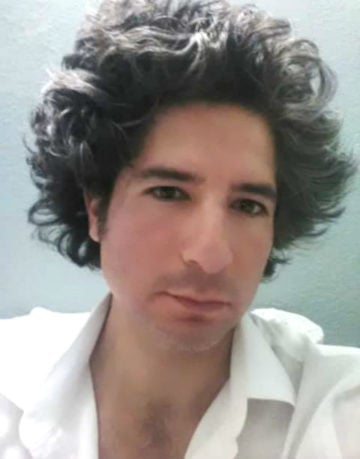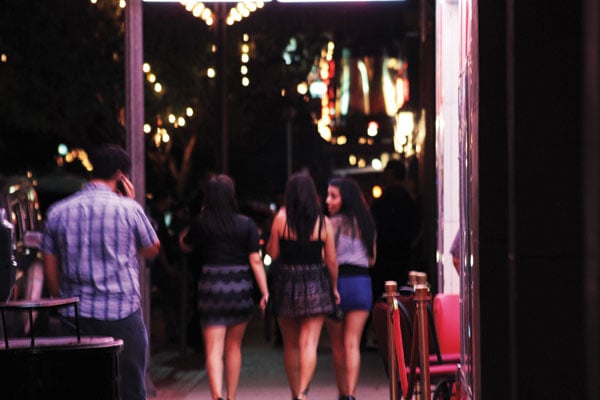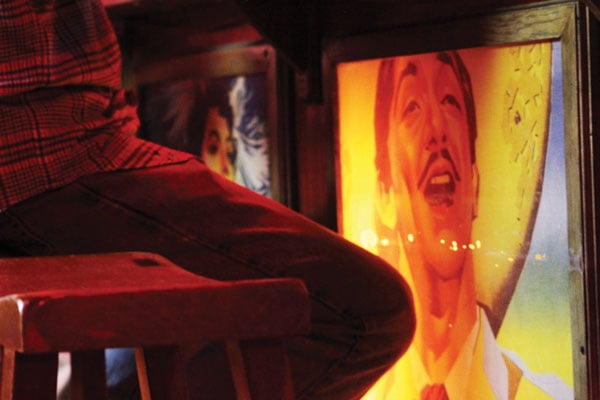Party Time in McAllen

WHEN I WAS 15, WEARING EYELINER and dressing like The Cure, I used to go to “Mex” (Mexico) on Friday and Saturday nights. A lot of other kids from McAllen would cross the border into Reynosa as well. You could be dressed like Robert Smith or that dude from Dead or Alive and have access to cheap drinks and cheap thrills and come home safe. I never drank because I didn’t want to get caught, and booze on the breath was the giveaway. My mom, a woman raised in an apostolic church in Mission, would have given me a hard time if she knew I was at these dirty, smoky, hole-in-the-wall discos with dayglow colors and black lights. But most of the kids that went to Mex—some for an after-school cocktail—had their parents’ consent.
Mex was safe … or safe enough. We called it “Mex,” like a brand name, or a soft drink. It was 1990, one year after Mark Kilroy, a University of Texas student, was murdered in Matamoros, across the border from Brownsville, during spring break. We were not scared by his death. This guy was an outsider coming across the border; we were locals. The dives across the border just wanted our money, and the weirdest thing that would ever happen was seeing your eighth- grade biology teacher getting down to Erasure’s “Oh L’amour.”
This isn’t the case anymore. Reynosa closes up at dusk because of drug-related violence in Mexico. People from the Rio Grande Valley and Mexico head to 17th Street, an entertainment district in downtown McAllen, to have a good time in safety. “You can’t tell who is from here or from there anymore,” says a young woman waiting to get into a club, “the crowd is all blended.” But as more people come to the entertainment district, crime and violence are also becoming issues in downtown McAllen.
 MCALLEN’S 17TH STREET was once known for spiritual soap and candle shops and prostitutes. Now, it models itself after Austin’s 6th Street. In the space of 12 blocks there are more than 50 urbane-looking establishments, bawdy beer joints and even an Italian-styled pizza place where everyone speaks Spanish and watches Mexican soccer on flat-screen TVs. Who knows where you are? Nearby, the Speak Easy—despite its name—blasts Alicia Keys and Lady Gaga. It started out as a piano bar, but had to change its musical offerings to stay afloat.
MCALLEN’S 17TH STREET was once known for spiritual soap and candle shops and prostitutes. Now, it models itself after Austin’s 6th Street. In the space of 12 blocks there are more than 50 urbane-looking establishments, bawdy beer joints and even an Italian-styled pizza place where everyone speaks Spanish and watches Mexican soccer on flat-screen TVs. Who knows where you are? Nearby, the Speak Easy—despite its name—blasts Alicia Keys and Lady Gaga. It started out as a piano bar, but had to change its musical offerings to stay afloat.
Joe Rodriguez is the driving force behind the nonprofit Heart of the City of McAllen Improvement Corporation, which has been on a crusade since 2004 to promote the downtown area and stimulate economic growth in this city of 130,000 people, just across the border from Mexico, and among the poorest cities in the nation. He admits that revitalization has been a struggle. “From 2006 to 2009 we tried really hard to change the image and clean it up, get rid of the drugs and prostitutes. Make it a place people wanted to be,” Rodriguez says.
“We’re never going to be 6th Street,” he says, a statement I’ve heard again and again. “Austin’s always going to be number one, but who will be number two, or three?” asks the 39-year-old, who learned about business selling oranges with his grandfather.
The area is booming, and liquor sales are bringing in considerable money. According to the Texas Comptroller’s office, between June 2010 and June 2011 17th Street was responsible for $1.8 million of McAllen’s beverage tax revenue. Rodriguez and business owners along 17th say the entertainment district is benefiting from the narco-violence in nearby Reynosa. “The revitalization is about giving the people of McAllen, who could just go across any time for a night out, an environment where they can still do that,” he says, “while at the same time, providing for the people on the other side a safe alternative to what they have now.”
BEFORE I EVER went to Reynosa to hear songs by The Smiths and Depeche Mode remixed and blasted out to the five-bucks-all-you-can-drink crowd, my skateboarder friends would ride down 17th Street and catch a bus into Reynosa to skate on the winding streets and grind along the public square, getting home in time for mom’s tacos and “The Cosby Show.” I never went on those bold treks because I was afraid of getting into trouble then.
Now there are other reasons for not crossing the border. You might get shot or abducted. The shops close early in Mexico’s border towns; armed officers are everywhere. Reynosa is a place where people die of drug-related violence. And few of the deaths are documented. Journalist John Gibler writes of Reynosa in To Die In Mexico: “All the talking took place inside a chamber of silence: there were no official statements, no local reports, and no national or international correspondents on the scene, no photographs, no radio interviews, no documentation, only talk. A friend said the city was under siege. A friend of a friend said people were afraid to go outside. Someone heard that the schools were empty. Parents terrified that their children would get caught in the crossfire on their way to school were keeping them at home.”
ON 17TH STREET, the weekend starts on Thursday night and crescendos on Friday and Saturday. The bars open at 9 or 10 p.m. and close at 2 in the morning. The street is a clash of worlds and intentions: The barbershop and the loan office, the ropa usadas and the herbarias are still there. The old Cine El Rey Theatre stands in contrast to the newer clubs, where kids line up to get inside. The landmark cinema once showed Mexican movies featuring Cantinflas and Tin-Tan. Now the theater has changed owners and given way to a hipper rock and comedy-night crowd.
Isaac Guerra, the 35-year-old owner of El Rey, has had his eye on McAllen’s revitalization since the inception of the Heart of the City project. He is an artist and musician for whom generating capital is an aesthetic pursuit. “The best art is making money,” Guerra says. The line almost perfectly echoes one of Andy Warhol’s lesser-known dictums: “Making money is art and working is art and good business is the best art.”
Guerra plans to shop around recordings of the comedic talent that performs on his stage to cable television, and launch a Latino version of “Live at the Apollo.’’
The bartender at El Rey, tolerating a group of Texas State University business students demanding items for a scavenger hunt, says, “[17th Street] is never going to be like Austin’s 6th Street.” But you get the feeling that he is proud of that fact.

LOOKING AT THE old buildings on 17th Street, the hotel that has been stripped of its seedy past and made into a dance club, I’m reminded of the spooky fun of going to Mexico at night. As a teenager, I experienced those streets and shadows as simultaneously cursed and sanctified. A girl I knew had a lover she would see only when she went into Mex. They would spend their nights together, and he would go back to his rich, cosmopolitan world in Mexico and she to her lower-middle-class house across from McAllen High School. Another girl I knew would make up her face like a vampire, wear sexy stockings and try to look like a Latina Elvira when she went to Mex. The next day she would be in church giving her life back to the Lord.
Mex was like Casablanca and that donkey island in Pinocchio. With its mix of old culture and new fashion, 17th Street today looks like a grounded Cloud City, the city in the Star Wars series that was ruled by Lando Calrissian. He compromised with the evil empire to secure the city’s economic survival. While 17th Street has succeeded in making money for the city, it has its share of problems—though not as bad as that strip of clubs in Reynosa once was.
Some McAllen residents complain that city leaders may have inadvertently courted criminal activity and violence from the community, and from Mexico, by creating the entertainment district. In 2010, Chief of Police Victor Rodriguez told the McAllen Monitor that 17th Street was a “growing pain” for law enforcement, stating that adding more cops to the force was “a great relief” in addressing crime in the area.
Weary of drug thugs and criminal activity, people who want to go to 17th Street support cops on the sidewalks.
A comment in the Monitor about a December shooting on 17th Street and an increase of police officers in the area suggest that many people thought the street was doomed from its inception:
“Boy, 17th Street is becoming a big problem. Did our city leaders think of this when they created it? Of course not, because they only care about making more money.”
EARLY ON, Rodriguez advised 17th Street’s bars to charge more for drinks, discouraging younger customers in favor of an older clientele that is less likely to cause trouble. Regarding revenue from drinks, Rodriguez notes: “The profits would still be there and there would not be the kind of problems we’re seeing now.’’
Stories of knifings and gang fights are often unsubstantiated, but nevertheless keep people, especially the older, middle-aged crowd, away.
“People say all kind of things, and it’s all rumors,” Rodriguez says. I tell him about the bouncer who, pointing to a young woman standing outside a bar, claimed she was a prostitute.
“Oh, please,” Rodriguez says, shaking his head. “There are only four prostitutes that work this area and I can tell you where they are.”
Pointing a few blocks down the street toward a Catholic church, he says: “They stand right there. They’re about 50 years old, and they weigh about 300 pounds each. They do what they do from noon to 5 p.m. and then they go back home to Mexico.”
Rodriguez says the recent drug violence has turned these ladies of the evening into women of the afternoon. “Even this shoeshine guy comes in early and is gone [back to Mexico] by five.”
“Look, all cities have their problems, their crime and their drugs, and this downtown area is the same,” Rodriguez says.
TED BOROWITZ, a martial arts instructor in his 20s, occasionally goes to 17th Street to meet friends: “[It] can be safe, but they should close it off; no more parking, make it entirely pedestrian. Maybe open some side pocket places. Shut it off to traffic. Get those hansom cabs going. Add some street performers. Jazz it up, and that would force out the other element.”
Sam Tapia, who also visits the area infrequently, says, “17th Street is unfortunately going in a bad direction.” If you’re not dressed right or if you’re over 25 then you don’t get good service, he says. “17th Street used to be a nice place to be. I liked coming. Then it started changing for the worse.”
“So why are you still coming?” I ask.
“Because you can’t go to Mexico anymore,” he says. “And there is nowhere else to go.”
Roberto Ontiveros is an artist, writer and contributing editor to Latino Magazine. His fiction has appeared in The Threepenny Review and the anthology Hecho en Tejas.


